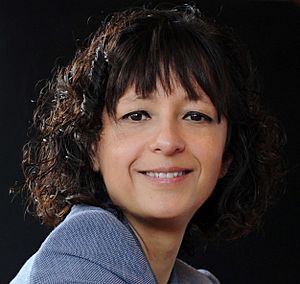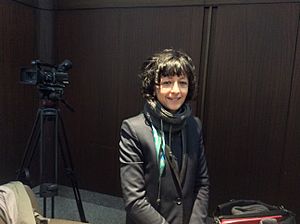Emmanuelle Charpentier facts for kids
Quick facts for kids
Emmanuelle Charpentier
|
|
|---|---|

Charpentier in 2015
|
|
| Born |
Emmanuelle Marie Charpentier
11 December 1968 Juvisy-sur-Orge, France
|
| Education | Pierre and Marie Curie University (BSc, MSc, PhD) |
| Known for | CRISPR |
| Awards |
|
| Scientific career | |
| Fields | |
| Institutions | University of Berlin University of Vienna Umeå University Max Planck Society |
| Thesis | Antibiotic resistance in Listeria spp (1995) |
| Doctoral advisor | Patrice Courvalin |
Emmanuelle Marie Charpentier (born 11 December 1968) is a French professor and scientist. She studies tiny living things (microbiology), how traits are passed down (genetics), and the chemistry of life (biochemistry). Since 2015, she has been a director at the Max Planck Institute for Infection Biology in Berlin, Germany. In 2018, she started her own research center, the Max Planck Unit for the Science of Pathogens.
In 2020, Charpentier and American biochemist Jennifer Doudna won the Nobel Prize in Chemistry. They received the award for creating a way to "edit" genes using a tool called CRISPR. This was the first time a science Nobel Prize was awarded only to two women.
Contents
Early Life and Education
Emmanuelle Charpentier was born in 1968 in Juvisy-sur-Orge, France. Her grandfather was an Armenian who came to France during the Armenian Genocide.
She studied biochemistry, microbiology, and genetics at the Pierre and Marie Curie University in Paris. From 1992 to 1995, she was a student at the Institut Pasteur. She earned her PhD there. Her PhD research looked into how bacteria become resistant to antibiotics.
Career and Discoveries
After her PhD, Charpentier worked as a researcher in France and then in the United States. From 1996 to 1997, she was at Rockefeller University in New York. There, she studied how bacteria like Streptococcus pneumoniae change their DNA. She also helped show how these bacteria can become resistant to medicines like vancomycin.
She continued her research at the New York University Medical Center and other places in New York until 2002. She even published a paper about how hair grows in mice!
In 2002, Charpentier moved back to Europe. She became a lab leader and professor at the University of Vienna in Austria. In 2004, she made an important discovery. She found an RNA molecule that helps control how harmful Streptococcus pyogenes bacteria become.
Later, Charpentier moved to Sweden, working at Umeå University. Then, in 2013, she moved to Germany to lead a department at the Helmholtz Centre for Infection Research. In 2015, she became a director at the Max Planck Institute for Infection Biology in Berlin. She also started her own research unit there in 2018.
Understanding CRISPR/Cas9
Charpentier is most famous for her work on a bacterial "immune system" called CRISPR/Cas9. She figured out how this system works and how it could be used as a tool to "edit" DNA. DNA is like the instruction manual for all living things.
She discovered a special small RNA molecule called tracrRNA. This molecule is super important for CRISPR/Cas9 to work correctly.
In 2011, Charpentier met Jennifer Doudna at a science meeting. They decided to work together. Their labs showed that the Cas9 part of the system could be used to make cuts in any DNA sequence they wanted. They found a way to combine Cas9 with a simple "guide RNA" molecule. This guide RNA acts like a GPS, telling Cas9 exactly where to cut the DNA.
This discovery meant that scientists could now easily edit the DNA of plants, animals, and human cells. Since then, CRISPR has changed the field of genetics. It allows scientists to change genes to learn about diseases and even develop new ways to treat them.
In 2013, Charpentier also helped start two companies, CRISPR Therapeutics and ERS Genomics. These companies work on using CRISPR technology.
Awards and Recognition

Emmanuelle Charpentier has received many important awards for her groundbreaking work. In 2015, Time magazine named her one of the 100 most influential people in the world, along with Jennifer Doudna.
Some of her major awards include:
- The Nobel Prize in Chemistry (2020)
- The Breakthrough Prize in Life Sciences (2015)
- The Louis-Jeantet Prize for Medicine (2015)
- The Gruber Foundation International Prize in Genetics (2015)
- The Leibniz Prize (2016)
- The Tang Prize (2016)
- The Japan Prize (2017)
- The Kavli Prize in Nanoscience (2018)
- The Wolf Prize in Medicine (2020)
She has also received many honorary doctorate degrees from universities around the world, including New York University and the University of Cambridge. She is a member of several important scientific organizations, like the U.S. National Academy of Sciences.
See also
 In Spanish: Emmanuelle Charpentier para niños
In Spanish: Emmanuelle Charpentier para niños


